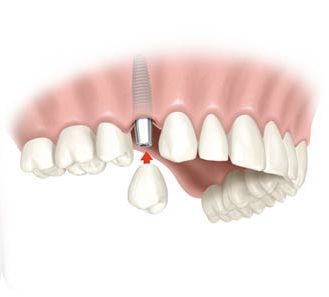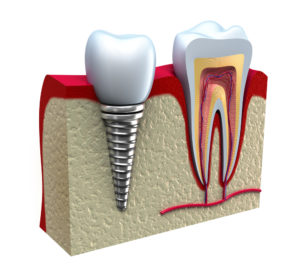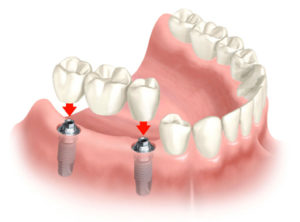
The Expert Explains the Art and Science of Implant Dentistry
A dental implant can be thought of as an artificial tooth root that is submerged into the jawbzone. When dental work such as a crown, fixed bridge, or a full set of dentures is added, one or more missing teeth can be replaced. A dental implant is fabricated from a very strong material (titanium) that is compatible with your body and is placed in a simple office procedure which generally is no more inconvenient than a tooth extraction. After an initial healing period during which the implant is buried in bone and left undisturbed under gum tissue, it is uncovered and connected to a small metal post that secures and supports the artificial teeth.
Our implant system is one of the easiest to place. It is also one of the most secure as bone grows into a 3-dimensional honeycomb network on its surface to integrate it with the bone.
Dental implants are like a third set of teeth. They feel much more natural and secure than traditional removable denture plates, especially if these are loose-fitting because of extensive bone loss. If several adjacent teeth are missing, a fixed bridge may be attached to dental implants as an alternative to a removable partial denture plate. Dental implants allow for the replacement of a missing tooth without having to modify adjacent teeth. Your surgeon will be happy to discuss alternatives for restoring your dental function with you.

Reasons to Get Dental Implants
- Strong & stable (tightly fixed)
- The only fixed alternative in situation where gaps at the rear end or where there are no natural teeth available for fixed bridge abutment
support - A stable, secure solution that lets you eat what you want
- Gives better strength and stability than dentures
- Preserves your facial appearance and prevents bone loss
- Gives a nice natural smile
- Offers a long-lasting solution, often for life
- Renewed confidence and improved quality of life as well
- No more caries for dental implant
- Save adjacent teeth. Prevents bone loss and exisiting teeth from drifting into surrounding space of the missing teeth
Missing One Tooth
Single-tooth implants can be used in people who are missing one or more teeth. An implant is surgically placed in an opening that is made by your dentist in the jawbone. After the implant integrates (attaches) to your bone, it acts as a new “root” for the crown that will be replacing your missing tooth. A crown (cap), which is made to look like a natural tooth, is attached to the implant and fills the space left in the mouth by the missing tooth.

Missing Serveral Tooth
Depending upon the number of missing teeth, the same number or a fewer number of dental implants might be required. For example, the replacement of 3 teeth can be carried out using a 3 unit bridge placed over 2 implants.

ADDRESS 1
Abha Tooth World
Janta Colony,
Near Chandra Medicos,
Vaishali Nagar,
Ajmer- 305001(Rajasthan), India.
Phone No: +91-8003217749
Email ID: Mohit07oblivion@gmail.com
Address 2
Abha Tooth World
Near Murjani Medicos,
Panchsheel B Block,
Panchsheel,
Ajmer - 305001(Rajasthan), India.
Phone No: +91-8003217749
EmailID:Mohit07oblivion@gmail.com
